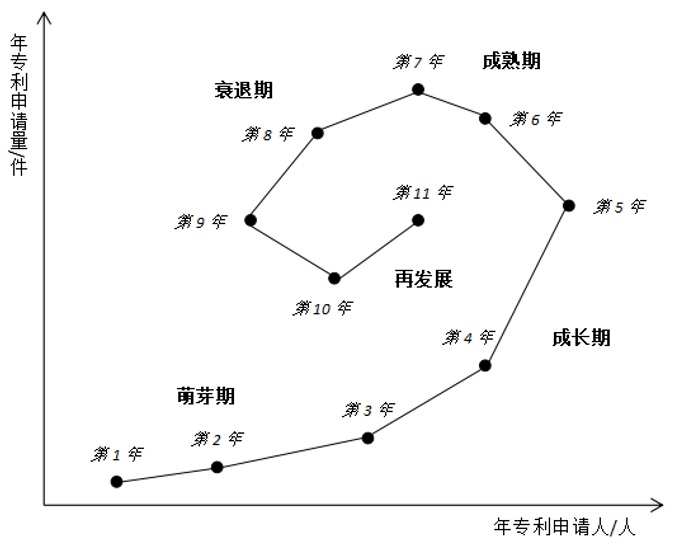 PDF(3493 KB)
PDF(3493 KB)


 PDF(3493 KB)
PDF(3493 KB)
 PDF(3493 KB)
PDF(3493 KB)
基于技术相似度和标杆分析的企业竞争对手及技术机会识别
Enterprise Competitors and Technology Opportunity Identification Based on Technology Proximity and Benchmarking Analysis
[目的/意义] 技术竞争是新市场环境下企业保持优势的有力武器,构建适合中小企业进行技术机会识别的流程框架,以期为企业挖掘有潜力的技术发展机会,充分利用有限的研发资源获得技术上的突破创新。[方法/过程]以标杆分析为主要方法,从技术相似与技术能力两个维度选取目标企业的竞争者标杆,结合标杆企业与行业整体技术态势框定潜力技术类别,最后引入时间维度构建三维技术-功效-时间矩阵识别技术机会,并以吸尘器行业为实例进行验证。[结果/结论]将时间维度引入技术功效矩阵,能够直观地体现技术研发的可持续性,构建的框架有助于保证所识别技术机会对于目标企业的可实施性。
[Purpose/significance] Technology competition is a powerful weapon for enterprises to maintain their advantages in the new market environment. The fundamental purpose of this paper is to construct a framework suitable for small and medium-sized enterprises to identify technological opportunities, so as to tap potential technological development opportunities for enterprises and make full use of Limited R&D resources to obtain technological breakthrough and innovation. [Method/process] Benchmarking analysis was used as the main method to select the competitor benchmarking of the target enterprise from the two dimensions of technical proximity and technical capability. Combined with the situation of benchmarking enterprises and the overall technical situation of the industry, potential technology categories were divided, and a three-dimensional patent technology/function matrix was constructed to identify technical opportunities, and the vacuum cleaner industry was taken as an example to verify. [Result/conclusion] The time dimension is introduced into the patent technology/function matrix to directly reflect the sustainability of technology research and development. The framework constructed helps to ensure that the identified technology opportunities can be implemented for the target enterprises.

benchmarking / patent analysis / technical opportunity identification / technology-effect matrix
| [1] |
MARIA M. Entrepreneurship: the engine of growth[M]. Westport: Praeger Publishers, 2007.
|
| [2] |
欧明臣,凌文辁. 标杆分析法在图书馆绩效评估上的应用[J]. 情报资料工作,2003(6): 47-49.
|
| [3] |
黄丹俞. 标杆分析在信息素养教育中的应用与研究——以南通大学图书馆为例[J]. 图书情报工作,2015, 59(24):65-71.
|
| [4] |
STALLMAN H M. University counselling services in Australia and New Zealand: activities, changes, and challenges[J]. Australian psychologist, 2012, 47(4): 249-253.
|
| [5] |
YANG, A M. Building global strategic alliances in the virtual space: a structural analysis of international nonprofit and nongovernmental organizations' transnational relationship networks[J]. Journal of public affairs, 2013, 13(3):239-250.
|
| [6] |
宋雪雁,张祥青,管丹丹,等. 基于MUSA模型的政府网站知识服务质量用户满意度实证研究[J]. 图书情报工作,2018, 62(23):32-42.
|
| [7] |
张红芹,鲍志彦. 基于专利地图的竞争对手识别研究[J]. 情报科学,2011, 29(12): 1825-1829.
|
| [8] |
FRY M, AJAMI A, BORG A. Bringing relevant information to diverse groups about emergency department services: the BRIDGE project[J]. Australian emergency nursing journal, 2004, 7(1):19 -22
|
| [9] |
黎欢,彭爱东. 竞争对手识别的三种专利引文分析方法研究——以全息摄影技术为例[J]. 情报杂志,2014, 33(10):78-82,71.
|
| [10] |
EPICOCO M. Knowledge patterns and sources of leadership: mapping the semiconductor miniaturization trajectory[J]. Research policy, 2013, 42(1): 180-195.
|
| [11] |
吴菲菲,杨梓,黄鲁成. 基于专利信息的企业潜在竞争对手识别——以OLED技术为例[J].情报学报,2017, 36(9):954-963.
|
| [12] |
李芳芳,王伟,穆晓敏,等. 基于专利分析的中药企业技术竞争对手识别[J]. 中华医学图书情报杂志,2019, 28(12):46-49.
|
| [13] |
PORTER A L, DETAMPELA M J. Technology opportunities analysis[J]. Technological forecasting and social change, 1995, 49 (3):237-255.
|
| [14] |
LEE Y, KIM S Y, SONG I, et al. Technology opportunity identification customized to the technological capability of SMEs through two-stage patent analysis[J]. Scientometrics, 2014, 100(1):227-244.
|
| [15] |
ZHU D H, PORTER A L. Automated extraction and visualization of information for technological intelligence[J]. Technological forecasting and social change, 2002, 69(5):495-506.
|
| [16] |
YOON J, PARK H, SEO W, et al. Technology opportunity discovery (TOD) from existing technologies and products: a function-based TOD framework[J]. Technological forecasting and social change, 2015, 100(11):153-167.
|
| [17] |
任海英,王倩. 技术机会发现方法的研究现状、趋势和问题[J]. 情报杂志,2020, 39(4):51-59.
|
| [18] |
YOON B. On the development of a technology intelligence tool for identifying technology opportunity[J]. Expert systems with applications, 2008, 35(1/2): 124-135.
|
| [19] |
王金凤,吴敏,岳俊举,等. 创新过程的技术机会识别路径研究——基于专利挖掘和形态分析[J]. 情报理论与实践,2017, 40(8):82-86.
|
| [20] |
ZHANG Y, ZHU D H, WANG X F, et al. Composing technology roadmapping according to bibliometrics: hybrid model and empirical study[C]//2011 international conference on computer communication and management, Singapore: Lacsit Press, 2011:405-410.
|
| [21] |
冯灵,余翔,张军荣. 基于专利信息的高铁技术机会分析[J]. 情报杂志,2015, 34(12): 95-100.
|
| [22] |
CHOI S, PARK H, KANG D, et al. An SAO-based text mining approach to building a technology tree for technology planning[J]. Expert systems with applications, 2012, 39(13): 11443-11455.
|
| [23] |
李乾瑞,郭俊芳,朱东华. 新兴技术创新机会识别方法研究[J]. 中国软科学,2018(11): 138-147.
|
| [24] |
郭俊芳,汪雪锋,邱鹏君,等. 基于SAO分析的技术路线图构建研究[J]. 科学学研究,2014, 32(7):976-981,1002.
|
| [25] |
KIM B, GAZZOLA G, LEE J M, et al. Inter-cluster connectivity analysis for technology opportunity discovery[J]. Scientometrics, 2014, 98(3):1811-1825.
|
| [26] |
韩燕,彭爱东. 基于技术形成三要素的技术机会识别研究——以医疗服务机器人领域技术为例[J]. 情报理论与实践,2020, 43(5):156-162.
|
| [27] |
龚惠群,刘琼泽,黄超. 机器人产业技术机会发现研究——基于专利文本挖掘[J]. 科技进步与对策,2014, 31(5):70-74.
|
| [28] |
冯立杰,王亚星,岳俊举,等. 基于多维空间专利地图的技术机会分析[J]. 科技管理研究,2017, 37(14):187-195.
|
| [29] |
黄鲁成,李晓宇,李晋.基于专利的ABOD-RFM技术机会识别方法研究[J].情报理论与实践,2020,43(9):144-149.
|
| [30] |
LEE C, KANG B, SHIN J. Novelty-focused patent mapping for technology opportunity analysis [J]. Technological orecasting and social change, 2015, 90(1):355-365.
|
| [31] |
陈旭,施国良. 基于情景分析和专利地图的企业技术预见模式[J]. 情报杂志,2016, 35(5):102-107,132.
|
| [32] |
高楠,彭鼎原,傅俊英,等. 基于专利IPC分类与文本信息的前沿技术演进分析——以人工智能领域为例[J]. 情报理论与实践,2020, 43(4):123-129.
|
| [33] |
邵波.企业竞争与反竞争情报中的专利分析[J]. 情报科学,2006, 24(3):361-364,372.
|
| [34] |
中国家用电器研究院,全国家用电器工业信息中心. 中国家电行业全年度报告(2020)[J]. 家用电器,2021, 28(3):50-73.
|
卢彦池: 论文选题与构思,文献整理,数据收集与分析,初稿撰写
卞艺杰: 论文大纲拟定,指导数据收集与分析,提出论文修改意见,参与论文修订
/
| 〈 |
|
〉 |